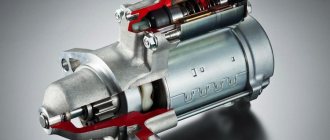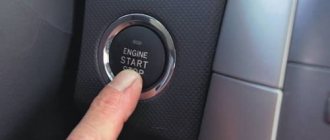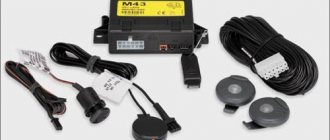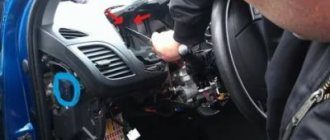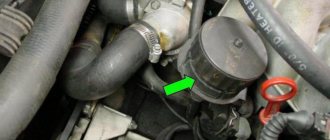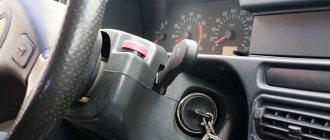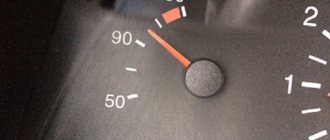Nothing happens when I turn the key in the ignition.
It happens that the driver tries to start the car, but when the key is turned in the ignition, nothing happens.
This kind of trouble often happens with domestic cars, especially those produced many years ago. According to reviews from owners, VAZ cars have a problem with the ignition switch. Modern technology has many sensors and prompts; in case of problems, it will sound the alarm in advance. Possible reasons for the lack of response when turning the ignition key lie in the battery, ignition coil, fuse box, contacts and wires. That is, they are connected with electricity. If the problem was in the cylinders, spark plugs, carburetor, fuel pump, or simply ran out of gas in the tank, the car would make some sounds. In this case, it is impossible to say that nothing is happening.
Battery
The battery may be completely discharged. There are many reasons for this - excessive use of electricity when the engine is not running (children could be playing in the garage), liquid or large insects getting on the terminals. Wet weather and having your car washed by a dubious service provider are risk factors. Too high or low air temperature has an adverse effect on the battery; it behaves unpredictably and sometimes discharges quickly.
To charge the battery while the engine is running, the generator must be in good working order and its belt must be well tensioned. Otherwise, even while driving, the battery runs the risk of being discharged soon, and this can lead to an emergency on the road. If you suspect a generator breakdown, it is better to immediately contact a professional. But before that, you should make sure that the problem is not in the battery or other parts.
If there is still some charge left in the battery, LED light bulbs and other energy-efficient electrical appliances may turn on. In old cars, you can find out exactly the voltage at the terminals with a tester; modern comfortable technology will show it on the dashboard (if the battery has not sat down to zero). If the voltage is insufficient, the recipe is clear - charging. They charge the battery from a power outlet or another car, but connecting to someone else's battery requires experience and caution.
If the battery discharges regularly and the ignition key continues to fail, you will have to replace the worn-out battery. Organizational measures will not hurt - for example, prohibiting children from being in the garage without adults.
Ignition coil
The coil increases the voltage so that a spark can jump through the spark gap in the spark plug. A step-up transformer is sensitive to moisture; dampness of the coil sometimes leads to failure. In this case, the headlights and all other electrical appliances are on; the complaint that when you turn the key in the ignition, nothing happens, applies only to starting the engine.
It is better not to jerk the key back and forth in the ignition switch to avoid a short circuit with severe damage to the coil. It needs to be examined and found out what condition it is in. It is clear that the voltage at the battery terminals must be normal when measured by any available method.
Fuse box
Relays located in the fuse box are one of the possible reasons why the ignition switch is not working as expected. If the battery voltage is normal, the car has not been washed or driven in the rain before, the fuse may have failed. In most car models, the problem can be visually found independently. Fuses are inexpensive and easy to replace. If this is the problem, when you turn the key the car will start. In front of the fuse box there is a common fuse that supplies voltage to the others.
Contacts and wiring
Wires are everywhere in the car. There are also enough of them inside the ignition switch. If this is the reason, the cost of repair depends on the location of the electrical circuit break and its nature. The wires can be soldered, the terminals can be cleaned and connected, but if the “insides” of the ignition switch have melted, you will have to change it.
A professional electrician will have a better idea, but many car owners successfully repair the wiring themselves. If nothing happens when you turn the key in the ignition, the lights don’t even light up, the circuit is probably broken closer to the battery. But when something lights up when you turn the ignition key, you have to look hard.
You should not pull the key repeatedly; the car should start perfectly on the first try. A tester helps check the “passability” of wires and contacts, of course, with the battery disconnected. If the assumptions are correct, the repairs will cost little or no financial costs. The surface of the terminals must be metallic and shiny. Perhaps it's time to clean them, preferably with a special paste.
It happens that the driver tries to start the car, but when the key is turned in the ignition, nothing happens. This kind of trouble often happens with domestic cars, especially those produced many years ago. According to reviews from owners, VAZ cars have a problem with the ignition switch. Modern technology has many sensors and prompts; in case of problems, it will sound the alarm in advance.
Possible reasons for the lack of response when turning the ignition key lie in the battery, ignition coil, fuse box, contacts and wires. That is, they are connected with electricity. If the problem was in the cylinders, spark plugs, carburetor, fuel pump, or simply ran out of gas in the tank, the car would make some sounds. In this case, it is impossible to say that nothing is happening.
Battery
The battery may be completely discharged. There are many reasons for this - excessive use of electricity when the engine is not running (children could be playing in the garage), liquid or large insects getting on the terminals. Wet weather and having your car washed by a dubious service provider are risk factors. Too high or low air temperature has an adverse effect on the battery; it behaves unpredictably and sometimes discharges quickly.
How does the engine start?
When the driver turns the ignition key, electric current is supplied to the solenoid relay. It moves the bendix until it engages with the teeth of the engine flywheel and at the same time closes the contacts of the starter itself, causing the crankshaft to rotate.
As soon as the engine cycle starts, the ignition key is returned to the “ignition” position, the bendix is retracted and the gears are disengaged. The mechanical circuit is quite simple, but all its components must work flawlessly, otherwise the engine will not start.
Why doesn't the battery light come on when the ignition is turned on? List of trivial problems
Car enthusiasts often wonder why the battery light does not light up when the ignition is turned on.
This is a fairly common problem. And almost everyone has encountered such a manifestation of a malfunction in the car’s energy system. And it’s one thing if such a malfunction occurs in the summer and 100 meters from the house. Such a breakdown is much more dangerous in cold weather on a country road, especially at night. Therefore, you need to know the causes of the problem, as well as how to fix it. There are several reasons for a light bulb to fail. You'll have to check all the options, fortunately it's not difficult. Basic electrical knowledge is sufficient. Why doesn't the battery light come on when the ignition is turned on? There may be several reasons for this behavior of the light bulb. Some of them are harmless, others indicate serious problems. Below we will look at the most likely reasons for this phenomenon. To troubleshoot, you will need a multimeter and a color wiring diagram of the car.
The lamp has burned out. A fairly common cause of this problem is the failure of the lamp. This is perhaps one of the simplest breakdowns, but it is not always harmless. It is advisable to replace the light bulb as quickly as possible. If there are problems with it, you will not be able to identify the problem with the generator in a timely manner. Which will lead to the battery being discharged at the most inopportune time. Thus, driving with a burnt-out lamp is highly not recommended.
You should also consider the design features of your car. Most generators have a built-in resistance. This allows you to generate energy even when the charge control lamp is burnt out. On some cars, the lamp itself plays the role of resistance. This can be found on some modifications of the VAZ 2112, as well as many old foreign cars. In this case, when the light bulb burns out, the generator stops producing current. If your car has this structure, you should always have a spare lamp.
Fuse A broken fuse may be the cause of a dashboard lamp failure. In this case, several devices usually fail at once. If such a symptom appears, you just need to check the fuse. It is located in the mounting block. You can find it using the diagram on the block cover. To check, the fuse is removed from the mounting block.
The easiest way is to install a known good fuse. If this is the reason, then the light should light up when the ignition is turned on. You can also check the fuse by measuring the resistance with a multimeter.
The whole process is described in detail in the article “How to check a fuse in a car with a multimeter.”
Circuit Failure If a light bulb does not light up, there may be a problem with the circuit supplying it. There are several nuances here:
- Problems with contacts. Quite a common problem. Usually appears after winter. During the cold season, moisture accumulates on the connectors, which causes the formation of oxides. The contact becomes significantly worse, as a result, the light bulb stops working. Typically, this problem manifests itself extremely unstable. One time it doesn't light up, the next time it works as usual. Clean all connectors and treat them with grease intended for this purpose;
- Circuit break. To identify the problem, you need to check the circuit using a multimeter. Perhaps there was a break somewhere. Find the faulty area and replace it;
- Relay problem. Some car models have a relay that controls the battery charge light on the panel. If this relay fails, the lamp will not light up. To check, use a multimeter to measure the voltage at the positive terminal of the relay. If there is a problem with the generator, the voltage will be less than 6 V; if the voltage is higher, the relay is faulty. It needs to be replaced. In detail about this, we wrote an article “How to check the generator regulator relay?”.
If the starter clicks
Problems with starting the engine can occur at any time of the year, but most often they appear in winter, when it is cold. The fact is that the battery loses its capacity when the ambient temperature drops. Consequently, it cannot provide the necessary power to the power mechanisms, which include the starter. And if the battery charge is low, the starter will not be able to turn over; clicks of the solenoid relay will be heard, the contacts of which will not even be able to close.
It is worth noting that the current consumption of this unit is very large - during cranking it can reach a value of 50-80 Amperes. And with a short circuit it even jumps to 700-800 Amperes. This happens when the crankshaft turns tightly or cannot be rotated at all. Consequently, in cold weather, when the oil becomes thicker, cranking becomes more difficult, the current drains, and the battery drains much faster.
General problems
Depending on the model, a car can use contact, contactless or electronic safety protection, and the popularity of the latter is gaining momentum today. Regardless of the type, if the car does not respond to the ignition key, this may indicate a problem with the system.
So, if the ignition system does not work, it may be due to:
- contamination, failure or damage to spark plugs;
- coil breakdown;
- loose connection of SZ components;
- broken wires;
- oxidation or burning of contacts, etc.
These are only general problems for all types of SZ, but depending on the type of unit, the list may be supplemented with other faults. For example, if we are talking about electronic SZ, then the reason may be the failure or incorrect operation of the ECU, as well as the breakdown of the input controllers.
If this is a non-contact SZ, then the cause of the problem may be:
- transistor switching device;
- advance regulator, both centrifugal and vacuum;
- lack of contact on the timing cover or its complete inoperability, etc.
Photo gallery “Failed SZ components”
How to remove the starter
To remove the starter, you will need one 13mm wrench. However, on some cars it is necessary to use a 13mm socket with a cardan and an extension. Removing the VAZ 2101-2107 starter turns out to be problematic, since the lowest nut is located in an inconvenient place. Many owners of these car models simply do not tighten the nut during assembly. In fact, the fasteners do not suffer from this. But in rare cases it can cause deformation of the body.
On VAZ cars of later models, for example, 2108-21099, there is no such drawback. All nuts can be unscrewed even with a spanner. However, in the case of using injection injection, inconveniences of a different kind arise - the air filter gets in the way. Removing it from the rubber cushions is problematic, so it is better to remove the starter from below. It can be easily removed on carburetor models in the same way.
What do you need to know about contactless safety equipment breakdowns?
If we talk about malfunctions of the non-contact ignition system, then the primary sign of malfunctions in its functioning is considered to be incorrect operation of the engine. If there is no ignition, the internal combustion engine may not start at all or will start only once, in addition, the engine will most likely function less stably in neutral gear. Also, one of the main signs is the inability of the car to develop power properly. It also happens that when trying to turn on the ignition, the driver sees that the warning lights on the panel are not lit. If the warning lights stop lighting, then the reason most likely lies in the lock itself, since this may be due to a lack of contact as a result of turning the key.
As for the main reasons, the following malfunctions are typical for non-contact SZ:
- Breakdown of the distributor cap is one of the most common problems; it usually occurs as a result of improper operation of the distributor or when it is worn out.
- A break in the circuit of high-voltage wires; as a rule, such a problem is associated with an insulation breakdown, which, in turn, is fraught with current leakage. Also, the reason may lie in poor contact of high-voltage batteries with spark plugs.
- Failure or wear of spark plugs, coil, controller or transistor switch. These elements can also fail due to wear and tear or improper use. As for the spark plugs themselves, they may not work correctly due to the constant use of low-quality fuel when refueling.
- Another common malfunction is a break from the stator winding controller.
- There is no contact at the switchgear output.
- A less common malfunction is the absence or disruption of contact between the wires and hardware elements of the SZ. If such a problem occurs, the driver will most likely hear uncharacteristic shots from the exhaust pipe.
- Increased gap in spark plugs (video author - Vyacheslav Chistov).
As practice shows, malfunctions in the operation of a contactless safety device can often be identified by increased fuel consumption. In this case, the reason is usually the failure or incorrect operation of the centrifugal or vacuum regulators, or both at once, or the failure of the spark plugs.
What elements need to be changed?
When carrying out a major overhaul of the starter, you need to change almost all of its elements. There is a bronze bushing in the back cover, which helps transfer power to the rotor winding. If not everything, then a lot depends on her condition. With a large gap between the rotor and the bushing, the transmission of electricity occurs much worse, therefore, a large amount of current will be lost.
What you need to know about electronic security problems
If, when you turn on the ignition, only some of the indicators on the instrument panel turn on, this may also be due to malfunctions of the SZ, although it is less likely. If we talk about malfunctions in the operation of the electronic SZ, then, as in any other case, malfunctions in its operation primarily affect the functioning of the power unit.
- The ignition does not turn on. When everything is bad, the system simply won't start.
- The engine starts, but with great difficulty. Sometimes the driver has to turn the starter for several minutes intermittently to start the engine. Ultimately, if the spark plugs are not primed, the engine will still be able to start.
- Loss of power from the power unit. When trying to accelerate, the driver may feel a dip; the car does not pick up speed. Such signs are especially obvious when driving uphill, in particular when driving in low gear.
- Unstable engine operation at idle. The engine may stall for no reason (the author of the video is Ramil Abdullin).
Battery condition
When the battery is discharged, a characteristic sign will be clicking noises from under the hood when trying to start the engine, which is produced by the retractor relay, as well as slow rotation of the crankshaft.
This occurs because with the low voltage supplied by a dead battery, the relay cannot be fully retracted and its core is thrown back by the return spring and the starter clicks. In addition, a low battery will be indicated by dim lights from the side lights and headlights, and after turning the key, the instrument lighting will go out almost completely.
When the battery is normally charged, the voltage at its terminals should be 12-12.4 volts. The voltage is measured with a multimeter. If it is below 11 volts, then starting will be difficult, in addition, the state of charge will not be enough to provide a large starting current.
Diagnostics and troubleshooting
Before repairing the ignition system, you need to find out exactly what needs to be repaired; this is why the check is carried out. First, the spark plugs are diagnosed , as well as the ignition timing - whether it is installed correctly or not. It is also possible that the reason lies in a damaged or failed distributor cap. If it is damaged, then it must be replaced in any case, since the insulation has already been damaged, and it will not be possible to restore it.
Any wires in the engine compartment must be well secured; if you notice that one of the sections of the circuit has worn out, then it should be replaced. If there are traces of brake or engine fluid, fuel or other liquids on the wires, they must be wiped dry and the problem of moisture ingress must be solved. If there is damage to any wires, including high-voltage ones, the cables must be replaced; in an emergency, in order to get to the nearest store, they must at least be insulated. As for the coil diagnostics, it is carried out using a tester - an ohmmeter, and the values obtained during the diagnostics must be compared with those indicated in the service book.
We have already written in more detail about diagnosing spark plugs in this article. If the problem is a lock failure, then before replacing it, you can try to repair the device. To do this, you will have to completely remove and disassemble the mechanism, identify damaged elements and replace them.
Disassembling the starter
It does not matter at all whether the Iskra starter or some other is used in the engine starting system. They are disassembled almost identically, since the design is identical for all. After removing the device from the car, it is advisable to clean it from dust and dirt. Then, using 8 or 10 wrenches, as well as screwdrivers, unscrew the two nuts that secure the back cover. Below it is the end of the rotor.
Do not rush to disconnect the starter parts, as there is a retaining ring on the rotor. You first need to remove it, after which you unscrew the two bolts located on the same diagonal. It is worth noting that there may be minor differences between two different starter models. After this, carefully separate the starter into three parts. The rotor should remain in the front cover. To remove it completely, you will need to remove the retaining ring and the bendix.
Security error
Car keys these days are coded or programmed, each to work with a specific vehicle. It's like a fingerprint, the code is unique and there cannot be two identical ignition keys (they never happen).
See also: 15 secrets to buying a used car
However, there are and may be “bugs” (glitches) in programming. Such software errors can confuse the car's security system and prevent you from starting the car.
Solution:
Modern security systems today require that when you start the car, you have with you exactly the key that is coded specifically for this vehicle. Even on cars with smart keys (where the key fob does not need to be taken out of your pocket and where the car is) problems can arise. Interference or weak signal for the car will become an obstacle. In this case, first you need to check the battery in the key fob (if it is discharged, replace it if necessary), or contact a car dealer for advice.
Starter bushings
Another reason could be worn copper-graphite bushings on which the rotor rests. One of them is pressed into the rear housing cover, where the brushes of the electric motor itself are located, and the front end of the rotor rests on a bushing, which is pressed into a hole in the clutch housing or in the starter housing itself, if the structure is closed.
The first option has almost gone out of use, because the bushing located in the clutch housing quickly breaks, the rotor begins to rotate misaligned and quickly becomes unusable. The second option is widespread almost everywhere, and bushings in this version are much more durable.
However, they also wear out over time and play appears, which eventually leads to jamming.
Rotation is not transmitted
Sometimes the car does not start, although the electric motor receives voltage and rotates the rotor. However, the force is not sent to the flywheel. We recommend looking for root causes based on the following factors:
- The bendix has broken down. The basis of its design is an overrunning clutch, which limits the rotation of the drive gear in only one direction. Damage to the mechanism will result in the inability to transmit torque to the flywheel.
- Flywheel teeth are damaged. From intensive use or after exceeding the permissible force on the ring gear, breakdown occurs. Its repair is quite labor-intensive, since it will be necessary to dismantle the gearbox.
- Broken timing belt or chain. The driver will be able to diagnose such a breakdown from inside the car by the extremely rapid rotation of the crankshaft and electric motor rotor. High speeds are a consequence of the lack of load created under normal conditions by the valve mechanism.
To restore functionality, you will have to restore the rotation transmission chain. New parts and repairs may be required.
Starter related problems
The main reasons are related specifically to the starter. There are quite a few elements susceptible to malfunction:
- Solenoid relay malfunction
- Contacts burning
- Bendix malfunction
- Gear wear
- Winding short circuit
The retractor relay moves the bendix until it engages with the flywheel. When the relay gets stuck, it stops moving and this is enough for the starter not to respond. To check, it is necessary to apply voltage directly to the power contacts. If it works, then that's the reason.
Poor operation of the solenoid relay, which causes it to click, is often caused by burning of the contacts. A very large current passes through them, so if they burn out, it is necessary to disassemble the relay and clean the contacts. However, this measure is only temporary, since these contacts are treated from the factory with a special coating, which wears off over time, and cleaning the contacts will only accelerate the wear process.
Bendix may also be the cause of the problem. To check it, you also need to close the contacts on the power relay. If the bendix is working properly, the rotor will rotate together with the bendix, but here it will be necessary to check the engagement of the gear with the flywheel. In addition, it is necessary to pay attention to the condition of the gear teeth and ring gear on the flywheel.
If they are worn or partially licked off, they may be slipping and not engaging well with each other. This malfunction will manifest itself in the form of a crackling sound when starting the engine or its free rotation without engagement with the flywheel. To ensure that the Bendix is working, the starter must be removed and manually checked for ease of movement of the gear.
Another reason may be a short circuit in the winding. In this case, even when voltage is applied directly to the starter contacts, it will remain silent. Removal and disassembly can confirm a short circuit.
Poor battery terminal contact
Over time, corrosion appears on the battery terminals. It can worsen the connection of the terminals with the battery contacts, which will ultimately lead to excessive heating created by the current during their operation due to excess resistance. And this, in turn, can quickly discharge even a good and new battery.
Solution:
Important to know: How to properly use your battery in winter
To prevent this process (discharge), simply clean the inner surface of the terminals with fine-grained sandpaper, the terminals will begin to fit more tightly and contact will be restored.
Summarizing
It is advisable that the starter spins the engine crankshaft during an attempt to start it for no more than 10 seconds, then the device must be given a minute pause. Failure to comply with this rule will, at best, lead to a discharge of the power source, and at worst, it will completely disable the starter. Only replacing it can save the situation, since not every auto electrician will undertake the task of rewinding burnt windings, since it is not always possible to perform this procedure efficiently. In addition, the cost of this service is comparable to the cost of a new element.
vote
Article rating
No spark
Faulty old spark plugs can cause a lot of trouble, namely, from uneven operation of the engine itself to the inability to simply start it. The symptoms of this disease are as follows: - the engine rotates, but does not start, there is no spark.
See also: How to prepare your car for summer after winter
In faulty spark plugs, there may simply be no spark at all, and it may also occur at an incorrect supply interval.
Solution:
Replacement of spark plugs with new ones. You will instantly feel the difference after replacing your old set of spark plugs with a new one. Engine performance will immediately improve, fuel consumption will decrease, and dips will disappear when the car picks up speed.
The interval for replacing spark plugs depends on many factors. Modern spark plugs can last up to 150 thousand km (car mileage).
Checking the crankshaft sensor
On most vehicles, a faulty PDAC will usually cause a trouble code, so use a diagnostic scanner. Or check the crankshaft sensor itself.
Magnetic DPKV
Crankshaft magnetic sensors can be tested by disconnecting the electrical connector and measuring the resistance between the corresponding terminals. If the resistance is not within specifications, the sensor is faulty and must be replaced.
Magnetic crankshaft position sensors produce alternating current when the engine is started, so checking the output voltage is another test that can be performed.
With the sensor connected, measure the output voltage at the sensor terminals when the engine starts. If you see at least 20 mV on AC, the sensor is good and there is probably a problem with the module.
If the output voltage is low, remove the sensor and inspect the end for rust or debris (magnetic sensors will attract metal particles). Clean the sensor, reinstall it and test again.
Make sure it has the proper air gap (if adjustable) as the distance between the end of the sensor and the ring gear or notches in the crankshaft will affect the sensor's voltage output. If the air gap is correct and the output voltage is still low, replace the sensor.
DPKV on the Hall effect
Hall effect crankshaft position sensors typically have three terminals. One is for current supply, one is for grounding and one is for output signal. The sensor must have voltage and ground to produce a signal, so check these terminals first with a multimeter.
Source: autorepairhelp.us
The sensor output can be checked by disconnecting the DIS module and cranking the engine to ensure that the sensor is producing a voltage signal. The voltmeter voltage should change each time a prong passes in front of the sensor. When observed on an oscilloscope, you should see a square wave shape. The absence of a signal indicates that the sensor is faulty.
Previous post Error P0016 - what it means, symptoms, causes, diagnosis, elimination
Next entry Error P0113 - what it means, symptoms, causes, diagnosis, solution
Broken fuel pump or relay
The worst case scenario with an empty fuel tank is that the fuel pump overheats and fails. Gasoline is also a coolant for it (it has a cooling effect); if you leave it without natural coolant, the pump will begin to take in air, which will certainly lead to overheating and premature wear of the pump, or complete failure.
Video: How to clean battery terminals using Coca-Cola
Solution:
Always keep an eye on the fuel gauge. Do not allow not only complete consumption of gasoline/diesel, but also its critically low levels. On some car models, it is recommended to keep the level in the tank at least ¼, or even 1/3, so that the fuel pump is always cool.
Unfortunately, you only have two options here, and both of them are not cheap. Have the fuel pump repaired or buy a new one.
